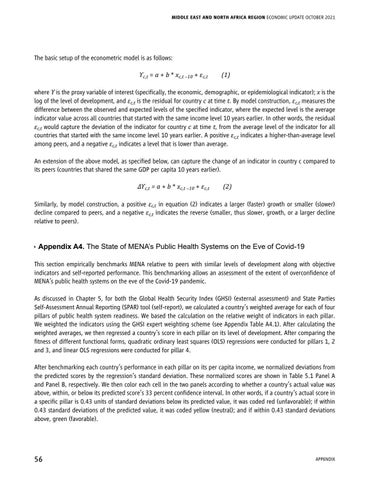MIDDLE EAST AND NORTH AFRICA REGION ECONOMIC UPDATE OCTOBER 2021
The basic setup of the econometric model is as follows: Υc,t = a + b * xc,t –10 + εc,t (1)
where Υ is the proxy variable of interest (specifically, the economic, demographic, or epidemiological indicator); x is the log of the level of development, and εc,t is the residual for country c at time t. By model construction, εc,t measures the difference between the observed and expected levels of the specified indicator, where the expected level is the average indicator value across all countries that started with the same income level 10 years earlier. In other words, the residual εc,t would capture the deviation of the indicator for country c at time t, from the average level of the indicator for all countries that started with the same income level 10 years earlier. A positive εc,t indicates a higher-than-average level among peers, and a negative εc,t indicates a level that is lower than average. An extension of the above model, as specified below, can capture the change of an indicator in country c compared to its peers (countries that shared the same GDP per capita 10 years earlier). ΔΥc,t = a + b * xc,t –10 + εc,t (2)
Similarly, by model construction, a positive εc,t in equation (2) indicates a larger (faster) growth or smaller (slower) decline compared to peers, and a negative εc,t indicates the reverse (smaller, thus slower, growth, or a larger decline relative to peers).
Ì Appendix A4. The State of MENA’s Public Health Systems on the Eve of Covid-19 This section empirically benchmarks MENA relative to peers with similar levels of development along with objective indicators and self-reported performance. This benchmarking allows an assessment of the extent of overconfidence of MENA’s public health systems on the eve of the Covid-19 pandemic. As discussed in Chapter 5, for both the Global Health Security Index (GHSI) (external assessment) and State Parties Self-Assessment Annual Reporting (SPAR) tool (self-report), we calculated a country’s weighted average for each of four pillars of public health system readiness. We based the calculation on the relative weight of indicators in each pillar. We weighted the indicators using the GHSI expert weighting scheme (see Appendix Table A4.1). After calculating the weighted averages, we then regressed a country’s score in each pillar on its level of development. After comparing the fitness of different functional forms, quadratic ordinary least squares (OLS) regressions were conducted for pillars 1, 2 and 3, and linear OLS regressions were conducted for pillar 4. After benchmarking each country’s performance in each pillar on its per capita income, we normalized deviations from the predicted scores by the regression’s standard deviation. These normalized scores are shown in Table 5.1 Panel A and Panel B, respectively. We then color each cell in the two panels according to whether a country’s actual value was above, within, or below its predicted score’s 33 percent confidence interval. In other words, if a country’s actual score in a specific pillar is 0.43 units of standard deviations below its predicted value, it was coded red (unfavorable); if within 0.43 standard deviations of the predicted value, it was coded yellow (neutral); and if within 0.43 standard deviations above, green (favorable).
56
Appendix

